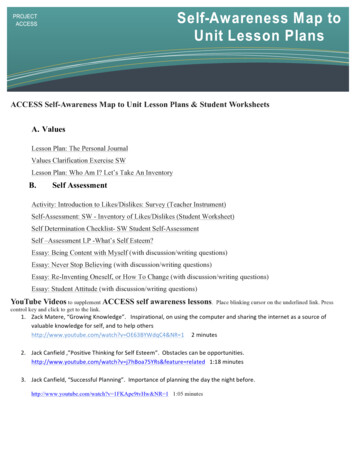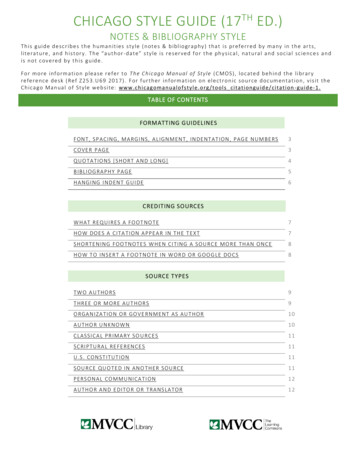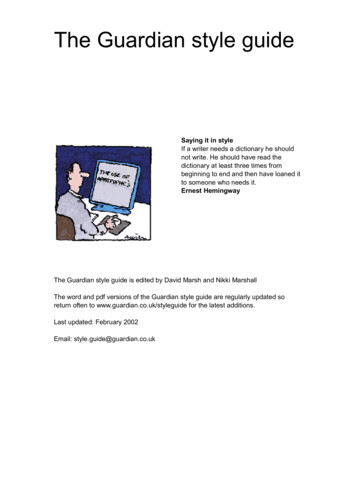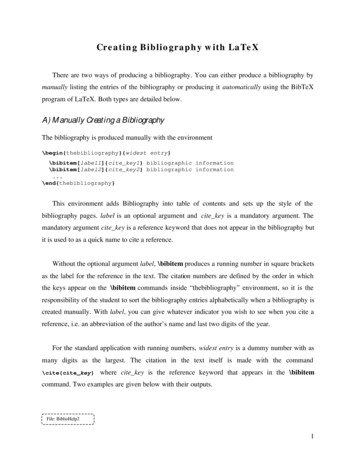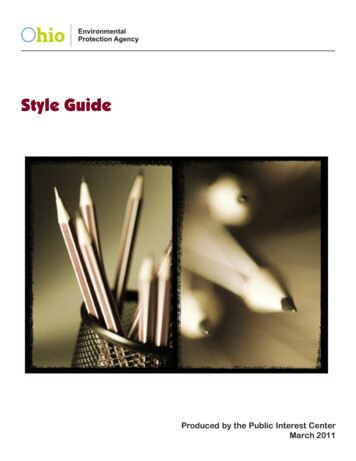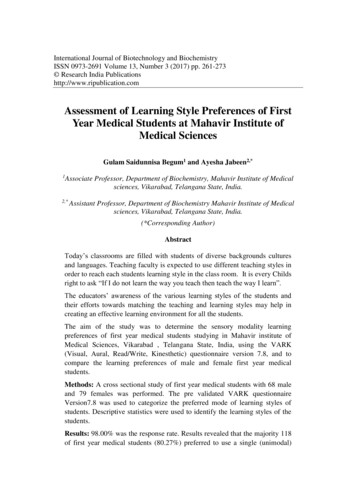
Transcription
International Journal of Biotechnology and BiochemistryISSN 0973-2691 Volume 13, Number 3 (2017) pp. 261-273 Research India Publicationshttp://www.ripublication.comAssessment of Learning Style Preferences of FirstYear Medical Students at Mahavir Institute ofMedical SciencesGulam Saidunnisa Begum1 and Ayesha Jabeen2,*1Associate Professor, Department of Biochemistry, Mahavir Institute of Medicalsciences, Vikarabad, Telangana State, India.2,*Assistant Professor, Department of Biochemistry Mahavir Institute of Medicalsciences, Vikarabad, Telangana State, India.(*Corresponding Author)AbstractToday’s classrooms are filled with students of diverse backgrounds culturesand languages. Teaching faculty is expected to use different teaching styles inorder to reach each students learning style in the class room. It is every Childsright to ask “If I do not learn the way you teach then teach the way I learn”.The educators’ awareness of the various learning styles of the students andtheir efforts towards matching the teaching and learning styles may help increating an effective learning environment for all the students.The aim of the study was to determine the sensory modality learningpreferences of first year medical students studying in Mahavir institute ofMedical Sciences, Vikarabad , Telangana State, India, using the VARK(Visual, Aural, Read/Write, Kinesthetic) questionnaire version 7.8, and tocompare the learning preferences of male and female first year medicalstudents.Methods: A cross sectional study of first year medical students with 68 maleand 79 females was performed. The pre validated VARK questionnaireVersion7.8 was used to categorize the preferred mode of learning styles ofstudents. Descriptive statistics were used to identify the learning styles of thestudents.Results: 98.00% was the response rate. Results revealed that the majority 118of first year medical students (80.27%) preferred to use a single (unimodal)
262Gulam Saidunnisa Begum and Ayesha Jabeensensory modality while learning, it was found that 47% had a preference forthe Kinesthetic (K) modality and 30% had a preference for the visual (V)modality followed by Auditory (A) 14% and Read/write (R) 9%. and 29students (19.73%) preferred multiple learning styles (multi modal). Amongthem 26 were bi modal and 3 were tri modal learners. The most preferredcombination of learning style among bimodal students were Visual Kinesthetic (VK) 10 students and Trimodal were equal (VAR, VRK, ARK)1 student each.Gender-wise analysis using Z- test for two proportions, showed no statisticalsignificant difference in unimodal however statistical significant was observedfor bimodal for sensory modality learning preferences.Conclusion: We conclude this study showed most students of this medicalcollege are able to learn effectively as unimodal (kinesthetic) however thefaculty should provide a blend of all other learning modalities to cater to theneeds of other students.Keywords: First year medical students, learning style, learning preference, theVARK. Learning style, Instructional method, and Teaching-learningstrategies.INTRODUCTIONThe educational world is acknowledging the importance of understanding the studentsdifferent learning style preferences and their role in attaining academic success [1, 2].Neuroscience research has also revealed that significant increases in learning can beaccomplished when the learning environments cater to their predominant learningstyles [3]. This is known as the “meshing hypothesis” [4].The term, ‘learning style’ describes an individual’s preferred method of gathering,processing, interpreting, organizing and analyzing information.The Fleming VARK Inventory Tool was primarily developed by Fleming [5] LincolnUniversity of New Zealand in 1998. . This provides the learners with a profile of theirlearning styles, based on the sensory modalities which are involved in taking ininformation. VARK is an acronym for the Visual (V), Auditory (A), Read/Write (R)and the Kinesthetic (K) sensory modalities. The visual learners process theinformation best if they can see it. The auditory learners like to hear information. Theread-write learners prefer to see the written words. The kinesthetic learners like toacquire information through experience and practice.Anatomy, Biochemistry and Physiology are important component of the medicalsyllabus during first year, the population of students who take these courses are very
Assessment of Learning Styles Preferences of First Year Medical Students.263diverse and represents many different age, cultural, language and educationalbackgrounds. This diversity presents academics with increasing challenges tomotivate and promote students understanding.The knowledge on the learning styles has implications for both the medical teachersand the students. The students identify their learning preferences, which can helpthem in using the appropriate learning strategies and as a result, they are more likelyto become lifelong self directed learners and to maximize their true potential. Theteachers become aware of the students’ learning styles and they can thereforeincorporate teaching-learning strategies which are tailored to meet the students’learning preferences. This would not only create an efficient learning environment,but it would also motivate the students to achieve academic success.It is also recommended that the learning preferences of medical students should beanalyzed prior to the start of their academic tasks by using VARK questionnaire, tofind appropriate teaching methods and to achieve educational goals.Aim: The aim of the study was to determine the sensory modality learningpreferences of first year medical students studying in Mahavir institute of MedicalSciences, Vikarabad, Telangana State, India, using the VARK (Visual, Aural,Read/Write, Kinesthetic) questionnaire [5] and to compare the learning preferences ofmale and female first year medical students.MATERIALS AND METHODSThis cross-sectional study involving first year medical students of the 2016-17 batch,was done at Mahavir institute of Medical Sciences, Vikarabad , Telangana State,India, after obtaining clearance from the Institutional Ethical Committee.A convenient sampling technique was adopted, the purpose of doing the study wasexplained and 148 of the 150 first year medical students of the 2016-17 batch,consisting of 62 males and 88 females, gave their written informed consent andparticipated in the study.The researchers, approached the participants in their classes during their free periods,who handed them the prevalidated VARK standard questionnaire version 7.8developed by Fleming, which could determine learning styles of students.The learning preference assessment tool, composed of 16 multiple choice questions,each having four choices. All choices correspond to the four sensory modalities whichare measured by VARK (visual, aural/auditory, read/write, and kinesthetic). Thestudents were instructed to select one or more choices, based on the sensorymodalities which are preferred by them, and to leave out a question if they felt that itdid not apply to them.
264Gulam Saidunnisa Begum and Ayesha JabeenScoring was done according to the instructions of the VARK questionnaire and thelearning preferences of the first year medical students were obtained. .Statistical AnalysisThe response from the students was entered in a Microsoft Excel sheet. Thedistributions of the VARK preferences were calculated in accordance with theguidelines given in the VARK scoring chart. Descriptive statistics were used for eachVARK component.The data was analyzed using the Statistical Package for the Social Sciences (SPSS)software, version 24 and the confidence level of 95% and Margin of error 5% powerof study will be 80%.Response distribution 50%. Acceptable level of significancewas set at P value 0.05.Percentages of students in each category of learning style preference along with Ztest for two proportions was used to analyze the difference in learning preferences ofmale and female medical students.Inclusion criteria: All first year medical students from the academic year 2016-17and who are willing to participate in the study.Exclusion criteria: Students suffering from acute/chronic illness/ taking medicationwill be excluded from the present studyRESULTS:Table -1 showing the demographics of the respondents with their sensory modalitylearning preferences.Total Number of students150Number of students participated147Response Rate98.00%Total Number of Male students68 ( 46.26%)Total Number of Female students79 (53.74%)Unimodal118 (80.27%)Multimodal29 (19.73%)Results revealed that the majority 118 of first year medical students (80.27%)preferred to use a single sensory modality while learning i.e., they had unimodallearning preferences (TABLE-1).
Assessment of Learning Styles Preferences of First Year Medical Students.265Table 2: Shows the mean and Standard deviation (SD) of V, A, R, K scoresindividually for both male and female respondents.Sensory modality learningpreferenceUnimodalNumber of studentsMean SDVisual (V)358.74 1.55Auditory (A)177.76 1.35Read/write (R)119.45 1.82Kinesthetic (K)558.81 1.67STUDENT VARK SCORES(118 STUDENTS)Kinesthetic(K)47%Visual (V)30%Read/write (R)9%Auditory (A)14%Fig 1: Shows the Percentage of Unimodal Sensory modality learning preferences offirst year medical students for both male and female respondents.Among multi modal learners, bimodal learners were 25 and tri modal were 3 learners.The most preferred combination of learning style among bimodal students wereVisual -Kinesthetic (VK) 10 students followed by Trimodal, VAR, VRK, ARK 1student in each category. (TABLE-3)
266Gulam Saidunnisa Begum and Ayesha JabeenTable 3: Sensory modality learning preferences of Multimodal first year Medicalstudents.Sensory modalitylearning preferenceBimodalMultimodalNumber of students and percentageMale: 13, Female: 16 (n 29)VR4VK10AR3VA3RK2AK4Tri-modal VRK1VAR1ARK1Quad-modalNilSensory modality learning preferences of Multimodal first year Medicalstudents.BIMODAL SCORES OF )VK38%(10)TRIMODAL SCORES OF(3) STUDENSTVRK34%(1)ARK33%(1)VAR33%(1)Fig 2: Shows the Percentage of Bimodal and Trimodal Sensory modality learningpreferences of first year medical students for both male and female respondents.
Assessment of Learning Styles Preferences of First Year Medical Students.267Gender-wise analysis of the sensory modality learning preferences of the 147 firstyear medical students consisting of 68 male and 79 female students was calculatedusing Z- test for two proportions, p value of 0.05 being taken as significant.(Table 4).On comparing single mode of Sensory modality learning information the followingshowed a significant variation between genders (p 0.05).Bimodal ( VK ) 1 male prefers to 9 females. So as compared to males, the femalespreferred information to be presented in a bimodal mode. This revealed there wassignificant difference in VK modality with Z-score -3.5777and p-0.00034Bimodal ( RK ) 2 males prefers to 0 females. So as compared to females, the malespreferred information to be presented in a bimodal mode. This revealed there wassignificant difference in VK modality with Z-score 2 and p-0.0455Bimodal ( VA ) 3 males prefers to 0 females. So as compared to females, the malespreferred information to be presented in a bimodal mode. This revealed there wassignificant difference in VK modality with Z-score -2.4495 and p-0.01428No significant difference in unimodal and other sensory modality learning preferencesamong genders was observed.
268Gulam Saidunnisa Begum and Ayesha JabeenTable 4: Comparison of the sensory modality learning preferences of male andfemale first year medical students.SensorymodalitylearningMales Females Z Score p value(n 66) (n 82)SignificanceV18170.810340.239not significant at p 0.05.A89-0.3430.72786not significant at p 0.05.R56-0.42640.6672not significant at p 0.05.K2431-1.3348 0.18352not significant at p 0.05VK19-3.5777 0.00034Is significant at p 0.05.VR22VA30RK2020.0455Is significant at p 0.05.AK13-1.41420.0455not significant at p 0.05AR21-1.4142 0.15854not significant at p 0.05.VRK100.8165 0.41222not significant at p 0.05VAR101.4142 0.15854not significant at p 0.05ARK011.4142 0.15854not significant at p 0.0501-2.4495 0.01428not significant at p 0.05.Is significant at p 0.05.DISCUSSIONIn this study, we administered the VARK questionnaire (version 7.8) to our first yearmedical students (Batch 2016-17) to determine their preferred mode of learning style.147 of the 150 students (98.00%) returned the completed questionnaires.In our study the Mean and SD VARK scores were kinesthetic (8.81 1.67) visuallearners (8.74 1.55) auditory (7.76 1.35) and reading/writing (9.45 1.82)learners.
Assessment of Learning Styles Preferences of First Year Medical Students.269Our study revealed that the majority of first year medical students preferred usingkinesthetic a single sensory modality while learning (unimodal).Probably the students during their schooling and collage studies (11 and 12thstandards) get exposed predominantly to lecture based teaching, they go home andread their text books to further understand what was taught. Thus, their teachingmethods are supportive of visual and auditory learners.Once they enter the medical school they get fascinated with hands on cadaverdissection, biochemistry and physiology practical’s and also enjoy different teachinglearning methods like projects based learning in terms of assignments, virtual roleplays in the form of videos and game based like cross word puzzles.Scientific research proved students remember 20% when they read, 30% when theyhear, 40% what they see and 50% what they say and 60% what they do, the retentionof information increases when they hear, see, say and perform. [17]To achieve effective learning, student must read, write and talk and actively involvedin task while learning. All this can be possible in active learning sessions which willgenerate motivation and enthusiasm. Active learning strategies not only encourage thecritical thinking but also improve problem solving, co operative learning withexchange of knowledge with peers and also become lifelong learner which is essentialfor medical profession.The findings of this study were similar to results of the study conducted by:Baykan and Kharb showed kinaesthetic was most preferred uni-modal learning styleamong medical students, in our study no one preferred uni-modal approach [ 6,7].In a study by Lujan and DiCarlo from a US medical school observed that first yearmedical students prefer multimodal way of learning and kinesthetic was the mostpreferred modality [8]. Similar reports from medical school were also reported fromMalaysiya [9] Saudi Arabia [10] Turkey [11] China [12] Similar observation is alsomade in a recent study from India by Shenoy et al. [13]which showed that 70% of therespondents preferred multimodal way of learning and they opted for kinesthetic.Dissanayaka T. [14] who found 73% unimodal and only 24 % students preferred weremultimodal learning style where as Shah C et all [15] found 43.30% unimodallearning style students in their study. In the present study among the four sensorymodalities the most preferred mode was kinesthetic and this finding is similar to thatof Baykan and Nacar. [16]When instruction in undergraduate courses matched student’s learning stylepreferences, students achieved higher scores than when mismatched.In most of the medical colleges, lectures are in the form of Power Point presentationor over head projectors and to some extent using black board are used to instruct all
270Gulam Saidunnisa Begum and Ayesha Jabeenstudents in the same way (i.e., a straight lecture format) classes are taught.Demonstrations and bed side clinics are mainly done for clinical subjects.Teaching faculty use this lecture format because of ease in passing information, theneed to cover large content, and perhaps due to their own preferences in teaching. Theresults of the VARK questionnaire should convince teachers to use multiple modes ofinformation presentation. By using a variety of teaching approaches, teachers willreach more students because of the better match between teacher and learner stylesHowever, our finding is in agreement with the finding of another study by MeechanAndrews in which students studying Physiology were found to have unimodalpreferences [18], and the study on first, second and third year dental students whichalso found that the majority of dental students had unimodal preferences, while only aminority (30.7%) had multimodal learning preferences [19].What is to be noted however is that the unimodal preference found in our study(80.27% unimodal vs 19.73% multimodal) had a preference for the kinestheticmodality followed by visual modality. Among multimodal, bimodal preference wasVK and Trimodal VRK, VAR and ARK were equally observed.Students with visual preference learn best by seeing or observing diagrams, pictures,graphs, power point presentations and flowcharts. Auditory learners gatherinformation best by hearing or recording lectures enjoy discussions and tutorials.Read/ Write learners prefer printed material like Assignments, Books, essays and liststo gain knowledge. Kinesthetic learners learn by using Projects, role play, real lifeexperiences, trial and error and hands on approaches OSPE AND OSCE. Studentslearners are capable of using all of these sensory modes input for learning, however,each individual has a unique preference, or set of preferences, in which one mode isdominant.CONCLUSIONWe conclude that our medical students distinguished themselves from otherpopulations by their strong learning preference for the kinesthetic modality.This finding should alert the faculty who teach first year MBBS who relypredominantly on Power Point presentations with diagrams and written matter in thetext. Such material would be preferred only by one section of their medical studentswith visual and read/write preferences.Recommendations: Present teaching styles do not support the student study, hencevarious workshops must be conducted by the medical education team to train andequip the faculty with various innovative teaching techniques to deliver knowledgeand information to the students to improve their acceptance. Faculty should adopt
Assessment of Learning Styles Preferences of First Year Medical Students.271multi modal teaching-learning strategies to create effective teaching and learningenvironment, to enjoy learning and to cater to the needs of other students.It is also recommended that the learning preferences of medical students should beanalyzed prior to the start of their academic tasks by using VARK questionnaire, tofind appropriate teaching methods and to achieve educational goals.Thus, we can conclude that we need to flip the class room from teacher to studentcentered and also to incorporate various different teaching styles to teach our differentlearners.LIMITATIONThis study has few limitations, firstly was done only on one batch of first yearstudents of one institution, faculty preferences also should have been considered ,larger sample size needed to increase the overall strength of our findings.ACKNOWLEDGMENTThe authors would like express our gratitude to management for their continuoussupport, encouragement and motivation for conducting this study. We also wish tothank Neil D. Fleming for the VARK questionnaire copyright version 7.8. Oursincere thanks to all the 1st year MBBS students, tutors and colleagues of MIMS fortheir co - operation and support throughout the study. We are thankful to, Mr.Waseem Abdul Khadeer for his statistical support.CONFLICT OF INTEREST: Authors have declared that no competing interestexists.REFERENCES[1]Williamson MF, Watson R L. Learning styles research: Understanding howteaching should be impacted by the way learners learn: Part III: Understandinghow learners’ personality styles impact learning. Christian EducationJournal. 2007;4(1):62–77.[2]Sternberg R, Grigorenko E, Zhang L. Styles of learning and thinking matter ininstructionandassessment. PerspectivesonPsychologicalScience. 2008;3(6):486–506.[3]Sankey MD, Birch D, Gardiner M W. The impact of multiple representationsof content using multimedia on learning outcomes across learning styles and
272Gulam Saidunnisa Begum and Ayesha Jabeenmodal preferences. International Journal of Education and Development usingInformation and Communication. Technology. 2011;7(3):18–35.[4]Pashler H, McDaniel M, Rohrer D, Bjork R. Learning Styles Concepts andEvidence. Psychological Science in the Public Interest. 2008;9(3):105–19.[5]Fleming ND, Mills C. Not Another Inventory, Rather a Catalyst forreflection. To Improve the Academy. 1992;11:137–55.[6]Baykan Z and Naçar M. Learning styles of first-year medical studentsattending Erciyes University in Kayseri Turkey. Adv Physiol Educ, 31, 2007,158-160.[7]Kharb P, Samanta PP, Jindal M, Singh V. The learning styles and thepreferred teaching learning strategies of first year medical students. J ClinDiagn Res, 7(6), 2013, 1089-1092.[8]Lujan HL, DiCarlo SE. First-year medical students prefer multiple learningstyles. AdvPhysiolEduc Educ. 2006: 30:13-6[9]Sinha NK, Bhardwaj A, Singh S, Abas AL. Learning preferences of clinicalstudents: A study in a Malaysian medical college. Int J Med Public Health.2013; 3:60-3.[10]Nuzhat A, Salem RO, Quadri MS, Al-Hamdan N. Learning style preferencesof medical students: A single-institute experience from Saudi Arabia. Int JMed Edu. 2011; 2:70-3.[11]Baykan Z, Naçar M. Learning styles of first-year medical students attendingErciyes University in Kayseri, Turkey. AdvPhysiolEduc. 2007; 31:158- 60[12]Yuemin Ding, Jianxiang Liu, Hong Ruan, Xiong Zhang. Learning Preferencesto Physiology of Undergraduate Students in a Chinese Medical School, I.J.Education and Management Engineering. 2012; 2: 81-85.[13]Shenoy N, Shenoy A, Ratnakar UP. The Perceptual Preferences in Learningamong Dental Students in Clinical Subjects, Journal of Clinical andDiagnostic Research. 2013; 7(8): 1683-85.[14]Dissanayaka T D. The learning style and preferred teaching –learningstrategies of first year Physiotherapy students. International Journal ofScientific and Research Publications. 2014;4(7);1-3[15]ShahaC,Joshi N,Mehata H B, Gokhale PA. Learning Styles Adopted armacy.2011;2(12):227-229
Assessment of Learning Styles Preferences of First Year Medical Students.273[16]Baykan Z and Nacar M. Learning styles of firstyear medical studentsattending Erciyes University in Kayseri, Turkey.Advances in PhysiologicalEducation. 2007;31: 158–160[17]Bonwell CC, Eison JA. Active Learning: Creating. Excitement in theClassroom. Washington, DC:George Washington University. 1991.In Shah C,Patel S, Diwan J, Mehata H. Learning Habits Evaluation of first M. B.B.SStudents of Bhavnagar Medical College. International Journal of MedicalScience and Public Health.2012;1(2):81-86[18]Meechan-Andrews TA. Teaching mode efficiency and learning preferences offirst year nursing students. Nurse Educ Today 2009; 29: 24-32[19]Haq SM, Yasmeen S, Ali S, Gallam FI. Students‟ learning styles requiremodified teaching strategies. Journal of Rawalpindi Medical College2012;16(2):191-193
274Gulam Saidunnisa Begum and Ayesha Jabeen
Assessment of Learning Styles Preferences of First Year Medical Students. 267 Gender-wise analysis of the sensory modality learning preferences of the 147 first year medical students consisting of 68 male and 79 female students was calculated using Z- test for two proportions, p
